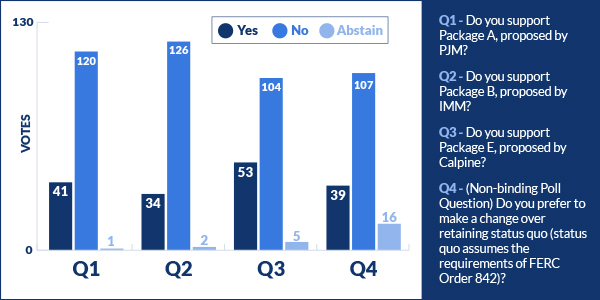By Rory D. Sweeney
VALLEY FORGE, Pa. — PJM will have to determine whether it wants to move forward without stakeholder endorsement on its plan to enforce primary frequency response (PFR) requirements beyond the standards of FERC Order 842 after members roundly rejected three proposals to revise the requirement.
RTO staff announced the results of a recent poll on the proposals at the Dec. 5 meeting of the Primary Frequency Response Senior Task Force (PFRSTF). None received more than 0.34 support; 0.5 was required to be advanced for consideration at the Markets and Reliability Committee. A question on whether PJM should make any change showed 0.73 in support of maintaining the status quo.
New units that enter the interconnection queue after Oct. 1 and existing units that request an uprate — including facilities that add units — will have to provide PFR, but there would be no new requirements for existing units that don’t make any changes. Generators have opposed proposals to require existing units to provide PFR. (See Primary Frequency Proposals Set for Vote in PJM.)
Stakeholders’ comments at the meeting reiterated the view that the proposals were, as FirstEnergy’s Jim Benchek put it, “a solution looking for a problem.”
“The thing about this is … it’s really an Eastern Interconnection thing … because each balancing authority has the obligation. Things are working,” Benchek said. “I would suggest that PJM … continue to monitor the situation, and if primary frequency response continues to degrade and needs to be addressed, then we restart this task force.”
American Electric Power’s Brock Ondayko agreed that the RTO should give Order 842 time to see if it corrects a trend PJM has noticed of reduced fleetwide PFR performance.
“In the meantime, I think PJM should probably explore the impacts of their own dispatch on the capabilities of units to provide [PFR],” he said. “The capability is so dependent on how PJM loads the assets, whether or not they have them moving prior to the [PFR event].”
Old Dominion Electric Cooperative’s Adrien Ford echoed the remarks, saying the poll results are “clear guidance” that the status quo is preferable.
“At this point, I think our work here is done,” she said.
Wider Concern
“Based on the latest webinar NERC held, I think there is indication that frequency response is declining in general. Is there someone jumping up and down saying, ‘The sky is falling’? I don’t think so. However, I think all the trends show we’re heading in that direction,” PJM’s Vince Stefanowicz said, noting that further delay risks NERC promulgating additional standards.
PJM’s Danielle Croop said that the overall trend is reflected within the PJM footprint.
“We have seen trending down in our frequency response … year over year for the past few years,” she said. “I definitely don’t think it’s PJM in a bubble that’s concerned about frequency response.”
Benchek assured that FirstEnergy’s units will continue to provide PFR and saw the potential for NERC to revise its standards as beneficial rather than a risk.
“We’re not going to take the governor controls off our units or anything,” he said. “We want to comply. We want to have a reliable system. It’s just not clear what we should do, so it’s maybe prudent to wait for better guidance.”
Other stakeholders asked PJM to continue to provide reports on unit performance and overall fleet response.
PJM’s Glen Boyle agreed to doing so.



